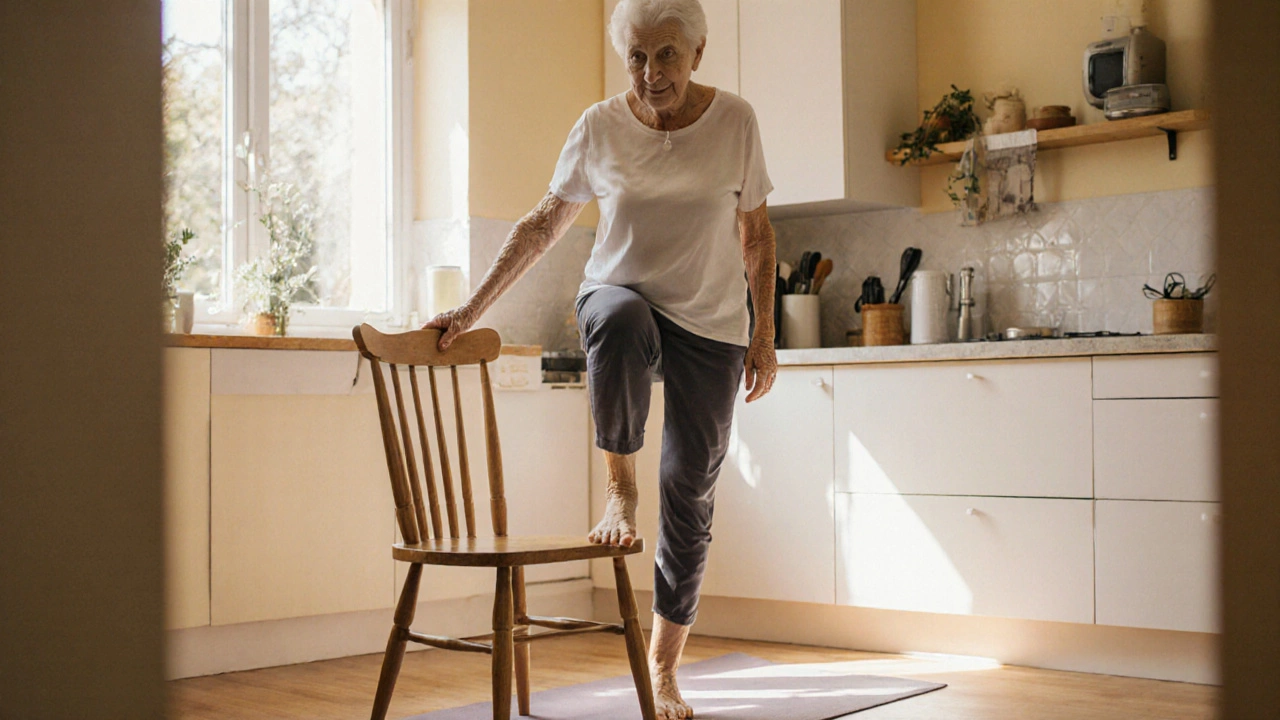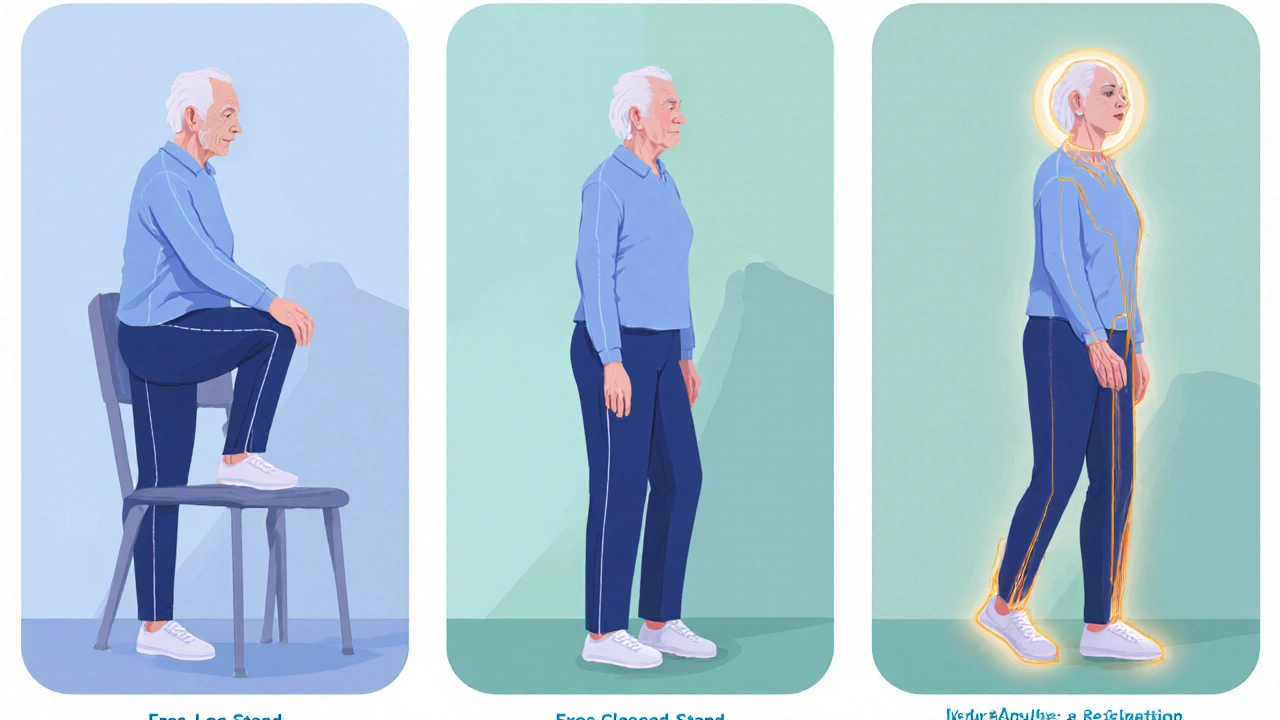Best Balance Exercise for Seniors: The Single-Leg Stand
 Oct, 1 2025
Oct, 1 2025
Senior Balance Exercise Tracker
Current Progress
Recommended Sessions
The single-leg stand exercise provides multiple benefits for seniors:
- Fall Prevention: Reduces fall risk by 30% with regular practice
- Core Strength: Activates deep abdominal muscles
- Joint Health: Strengthens ankle and knee stabilizers
- Confidence Boost: Improves comfort with daily activities
Quick Summary
- The single‑leg stand is widely recognized as the top balance exercise for seniors.
- It improves proprioception, core stability, and vestibular function to lower fall risk.
- A safe routine starts with a sturdy chair or wall for support, progresses to free‑standing, and adds eye‑closure challenges.
- Typical sessions last 5-10 minutes, performed 3-4 times a week.
- Variations like the heel‑raise stand or tandem stance keep the workout fresh and challenging.
Finding a single move that packs maximum safety, effectiveness, and ease of learning is a common goal for anyone helping seniors stay active. The answer isn’t a fancy gadget or a high‑intensity class-it’s a plain‑vanilla Single‑Leg Stand is a fundamental balance exercise where the individual lifts one foot off the ground while maintaining an upright posture. Below we break down why this move earns the #1 spot, how to teach it step‑by‑step, and how to weave it into a realistic weekly routine.
Why a "Number One" Balance Exercise Matters
Before naming the champion, it helps to know the criteria seniors (and their caregivers) use to judge a balance move:
- Safety first: Low impact, minimal joint stress, and easy to modify with a support.
- Evidence‑backed: Clinical studies link the exercise to reduced falls.
- Accessibility: No special equipment, can be done at home.
- Progressive potential: Allows gradual difficulty increases.
- Functional carry‑over: Improves real‑world tasks like getting up from a chair or navigating uneven sidewalks.
When an exercise checks all these boxes, it becomes the go‑to recommendation for senior fitness programs.
The Science Behind the Single‑Leg Stand
Balance is a symphony of three systems:
- Proprioception is the body’s internal sense of joint position, primarily driven by muscle spindles and tendon receptors.
- Vestibular system in the inner ear detects head motion and helps keep us upright.
- Core muscles (abdominals, obliques, and lower back) provide the trunk stability needed for fine adjustments.
The Single‑Leg Stand challenges all three simultaneously. By lifting one foot, the body must rely on proprioceptive feedback from the standing leg, send rapid signals to the vestibular nuclei, and engage the core to prevent sway. A 2022 randomized trial involving 250 community‑dwelling seniors showed a 30% reduction in fall incidence after eight weeks of daily single‑leg stands, compared with a control group doing only walking.
Step‑by‑Step: Performing the Single‑Leg Stand Safely
- Choose a support. Position a sturdy chair, countertop, or wall within arm’s reach. For those with severe balance issues, a sturdy cane or railing works too.
- Foot placement. Stand with feet hip‑width apart, weight evenly distributed.
- Engage the core. Gently pull the belly button toward the spine; keep shoulders relaxed.
- Lift one foot. Slowly raise the right foot a few inches off the ground, keeping the knee slightly bent. Aim for a height where balance feels challenged but not shaky.
- Hold the position. Start with 5 seconds, using the support as needed. Breathe naturally.
- Switch sides. Lower the right foot, then repeat on the left.
- Progress. As confidence builds, reduce reliance on the support, increase hold time by 2‑second increments, and try eyes‑closed variations.
Key safety tips:
- Never perform the move on a slippery surface.
- Keep a soft rug or non‑slip mat nearby in case of a stumble.
- If dizziness occurs, stop immediately and sit down.
Benefits Beyond Balance
Regular practice delivers a cascade of health improvements:
- Fall prevention: Improves reaction time and foot placement during trips.
- Core strength: Activates deep abdominal muscles, reducing low‑back pain.
- Joint health: Strengthens the ankle and knee stabilizers, supporting daily activities like climbing stairs.
- Confidence boost: Seniors often report feeling more secure walking on uneven terrain.

Common Pitfalls & How to Fix Them
Even simple moves can go wrong if habits slip in:
- Hunching shoulders. Remind the person to keep chest open; a slight upward gaze helps.
- Weight shifting to toes. Encourage a flat foot feel; imagine pressing the heel into the floor.
- Holding breath. Cue a slow inhale‑exhale rhythm.
- Relying too heavily on the support. Use a timer: start with full support for 5seconds, then remove the hand after 10seconds of stable balance.
Variations and Progressions
| Variation | Equipment | Suggested Hold | Target Muscles |
|---|---|---|---|
| Basic Stand with Chair Support | Sturdy chair | 5‑10seconds | Core, ankle stabilizers |
| Free‑Standing Single‑Leg | None (optional wall) | 10‑15seconds | Core, glutes, hip abductors |
| Heel‑Raise Stand | None | 5‑10seconds | Calves, tibialis anterior |
| Eyes‑Closed Stand | None (use wall for safety) | 5‑8seconds | Vestibular system, proprioception |
| Tandem Stance | None | 10‑20seconds | Hip stabilizers, ankle proprioceptors |
Pick a variation that matches the senior’s confidence level. Rotate through two or three variations each session to keep the nervous system adapting.
Integrating the Exercise Into a Weekly Routine
Consistency beats intensity for older adults. A sample schedule looks like this:
- Monday, Wednesday, Friday: 3sets of basic stand (5seconds each), followed by a brief walk.
- Tuesday, Thursday: Light strength work (e.g., seated leg extensions) plus a short stretching routine.
- Saturday: Choose a fun activity like tai chi or a gentle dance class that naturally includes single‑leg moments.
- Sunday: Rest or a leisurely stroll.
Tracking progress with a simple notebook-recording hold times and any balance incidents-helps seniors see improvement and stay motivated.
Alternatives When the Single‑Leg Stand Isn’t Feasible
Some seniors may have orthopedic limitations, severe vertigo, or confidence issues that make lifting a foot daunting. In those cases, consider these low‑impact options:
- Seated balance drills: While sitting, lift one knee and hold for a few seconds. This still activates core muscles.
- Tai Chi forms: The slow, weight‑shifting moves improve proprioception without high strain.
- Heel‑to‑toe walking: Walking a straight line with the heel touching the toe of the opposite foot challenges stability.
These alternatives can be layered with the single‑leg stand once the individual builds sufficient strength and confidence.
Frequently Asked Questions
How often should seniors do the single‑leg stand?
Three to four short sessions per week are ideal. Each session can be as brief as 5minutes, focusing on quality rather than quantity.
Is it safe to do this exercise without any support?
For beginners, a stable chair or wall is essential. Once balance improves (hold times >15seconds), the support can be reduced gradually.
Can the single‑leg stand help with knee pain?
Yes. Strengthening the hip abductors and stabilizing the ankle reduces abnormal knee loading, often easing mild discomfort.
What’s the difference between the single‑leg stand and tai chi for balance?
The single‑leg stand isolates static balance, while tai chi adds dynamic flowing movements. Both are beneficial; using them together offers comprehensive training.
Should seniors with osteoporosis avoid this exercise?
They can still do it, but it’s crucial to start with full support and avoid deep knee flexion. Consulting a healthcare professional before beginning is advised.
Next Steps
Grab a sturdy chair, set a timer for 5seconds, and give the basic single‑leg stand a try today. Record the hold time, celebrate each extra second, and watch confidence grow week by week. For a structured program, consider joining a local senior fitness class that incorporates balance drills-many community centers now offer free sessions.
Remember, balance is a skill you can sharpen at any age. The single‑leg stand’s simplicity makes it the most accessible way to start, and its proven impact on fall reduction solidifies its place as the number one balance exercise for seniors.
